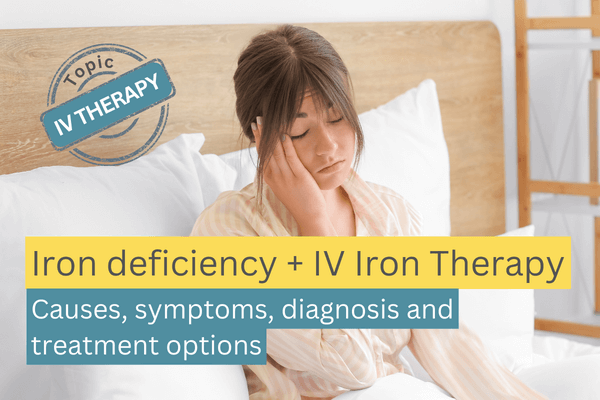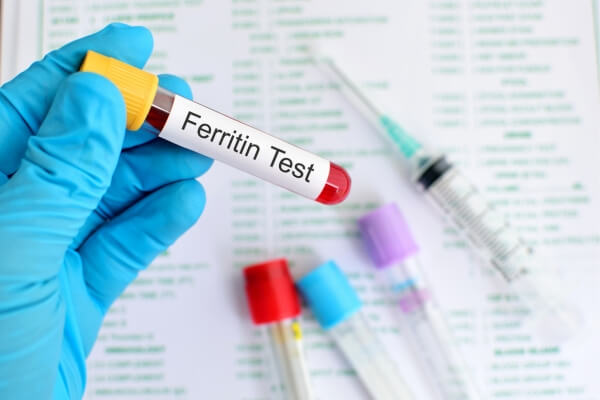
Iron deficiency and iron infusion (IV therapy)
In this article we would like to give you an overview of the topic of iron deficiency and the possibility of iron infusion.
Iron deficiency is a common disorder that can affect both your quality of life and your health. This article is intended to provide you with a deeper understanding of the causes, symptoms, diagnosis, and treatment options for iron deficiency, particularly the treatment regarding iron infusion.
Table of contents
Iron deficiency: causes and symptoms
Iron is an essential trace element in the human body, fundamental for oxygen transport, energy production and maintenance of cellular functions. The total amount of iron in the body is 3-5 g, of which approx. 70% is bound in hemoglobin (=red blood pigment) – i.e. approx. 2.8 g. Assuming that an adult has about 5 liters of blood, this makes about 0.56 g or 560 mg of iron per liter of blood.
Iron deficiency can be caused by several factors, including:
- Insufficient iron absorption: This can occur due to an unbalanced diet, a vegetarian or vegan diet, or after surgical procedures in the gastrointestinal tract.
- Increased iron requirements: During certain phases of life, such as pregnancy, breastfeeding or intense physical training, iron requirements may be increased.
- Chronic diseases: Some diseases such as inflammatory bowel disease can impair iron absorption.
- Iron loss due to chronic blood loss: women in particular lose iron through their monthly menstrual period, as blood contains a lot of iron. An iron deficiency is also always an indication of possible bleeding in the body. It is the first place to look regarding the diagnostics of the gastrointestinal tract. Appropriate diagnostics by means of endoscopic examinations should be performed, especially in cases of recurrent iron deficiency.
Symptoms of iron deficiency can be varied and include:
- Fatigue and exhaustion
- Paleness of the skin and mucous membranes
- Shortness of breath (especially on exertion) and dizziness
- Brittle nails and hair loss
- Mouth angle tears (cheilitis angularis) and recurrent aphthae of the oral mucosa
- Tongue burning and atrophy of the oral and pharyngeal mucosa
- Concentration disorders and cognitive deficits
- Heart palpitations (palpitations)
- Plummer-Vinson syndrome: triad of pain on swallowing (dysphagia), iron deficiency anemia, and atrophy (wasting away) of the mucosa of the esophagus
- Sleep disorders, depressive episodes and neck tension.
- Restless legs syndrome
- Anemia in severe cases
- Chronic iron deficiency in children: Possible cognitive and neurological deficits and growth disturbances
You can also find a very good overview here:
https://www.rosenfluh.ch/media/arsmedici/2008/09/Das-Eisenmangelsyndrom-IDS-Iron-Deficiency-Syndrome.pdf
Diagnosis of iron deficiency
Iron deficiency is usually diagnosed by a combination of laboratory tests, including:
- Serum Ferritin: This protein reflects the body’s iron stores. Here it is important to include the CRP value at the same time. This is an inflammatory value, and in the context of inflammation, the ferritin value is falsely high (ferritin is an acute phase protein). Relevant inflammation is indicated and detected by the CRP value.
- Hemoglobin and hematocrit values: Low values may indicate iron deficiency.
- Transferrin saturation: It shows how much iron is present in the blood.

Iron infusion: what is it?
When iron deficiency is present there are two options: Oral or intravenous (IV) iron replacement therapy. Oral therapy is the treatment of first choice, especially for mild iron deficiency. The oral preparations are often not so well tolerated, especially if the patient has previous gastrointestinal complaints (e.g., flatulence, bloating, constipation, etc.).
We usually give iron intravenously. We use the iron supplement Venofer®. We calculate your iron deficit using a formula and usually infuse the amount of iron needed in 3-4 infusion therapy sessions. Two sessions can be conducted per week. Four to five weeks after the last infusion, the ferritin value (and the CPR value) is checked again. The ferritin value should then optimally be above 75-125 nanograms/milliliter. At levels below 40-50 nanograms/milliliter, iron deficiency is present and symptoms may be present. The lower limits used in Germany are set much too low. We are guided by the American limits. You can find more information here: https://www.naturheilmagazin.de/naturheilverfahren/ferritin-eisenmangel/#c9031
For further information, please do not hesitate to contact us. Feel free to contact us anytime and arrange an appointment via Doctolib if you have any questions.
Stay healthy and informed!
Dr. Stefan Rohrer
More articles on the topic of infusion therapy:
– Vitamin C High-Dose Therapy – procedure & benefits
– Alpha Lipoic Acid IV Therapy: a secret tip for your health
– Glutathione infusion: procedure & benefits
